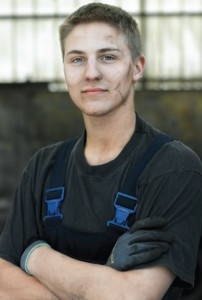Words by Chris Carriere
The first day of junior kindergarten is hard for every kid. For Kieran, though, it was a little bit different. What started as first-day jitters had, by the next year, developed into a definite pattern of non-participation, say parents Sarah and Alan.
By grade one, Kieran was struggling with reading; by grade two, he was struggling right across the board. His teachers (who can’t diagnose developmental problems, but can recommend a child be assessed) suggested he might have a learning disability.
“They told us he couldn’t follow two-step instructions—yet at home, he could rewire all of the electronics in the house,” Alan says. “Were we just biased, we wondered?”
Increasingly, it seemed that they weren’t. They hired a tutor, who found that Kieran performed quite well. They had him formally assessed at a major private school in Oakville. The verdict? No learning disabilities of any kind. Vindicated, they showed the report to Kieran’s teachers.
“They told us, ‘We can’t help you,’” Alan says.
Sarah, Alan and Kieran don’t actually go by those names, but I’m willing to bet that their story sounds familiar. Across Mississauga, across Peel, across Ontario and Canada and beyond, boys are struggling to fit into an education system that just doesn’t work for them. And the ramifications reach far beyond their classroom walls—into their homes, their personal lives, their burgeoning careers, or their lack thereof.
“I absolutely am worried,” Sarah says. “If I look at my circle of friends, there’s one boy who is thriving in the current school system. One out of sixteen.”
So what’s the deal with boys?
Over the past two decades, we’ve largely stopped talking about education equality for girls, and started talking about education equality for boys. And with good reason; the statistics don’t lie. Sixty percent of university students are female. Boys routinely lag behind girls in standardized test scores, particularly reading and writing. They’re far more likely to drop out, feel alienated, be diagnosed with ADHD and have problems with bullying.
But the stats don’t tell the whole truth, either. How can they, when at the same time as the Peel School Board is preparing a long-term overhaul of their curriculum, author Michael Reist (Raising Boys in a New Kind of World) can claim that “there is no crisis”?
Once you start talking to the experts, a pattern of buzzwords starts to emerge. Kinesthetic learner: somebody that absorbs information more effectively through motion and activity. Factory-model schools.
“It goes back to the beginning of schooling in Ontario,” says Reist. “Our system is based on a factory model: the teachers are the workers and the kids are the product, and we try to meet these specifications.”
Both Hazel Mason, a Superintendent of Education with the Peel District School Board who has been with the board for 31 years, and Aaron Sawatsky, the head of St. Jude’s Academy, agree that a big part of the problem is that boys are just not being engaged on a physical level.
“We’re still in that place where kids have to sit for long periods of time and pay attention,” says Mason. “Boys are just very active people. I’m not saying some kids don’t have ADHD, but for many boys the kind of teaching and learning we’ve been doing for a number of years simply doesn’t match their learning style.”
“A typical classroom is just set up to be a more feminine environment,” the plainspoken Sawatsky claims. “Girls are just a whole lot better at the sitting there and shutting up thing than boys.”
Like Mason, most educators are reluctant to claim that ADHD or other learning disorders are overdiagnosed—the research clearly shows that, for many kids, medication is a lifesaver. But many will readily agree that, in a carefully structured scholastic environment offering a single mould that many boys don’t fit, we have turned the hallmarks of boyhood into symptoms. Even the expectation that boys “talk through” problems may be predicated on a preference for skills where girls naturally dominate, says Sawatsky.
“Early on,” adds Reist, “boys get the message that school is not for them. As early as the primary division, boys get the impression that something is wrong with them, because they love to move… We need to stop the self-fulfilling prophecy of ‘boy you can’t read, boy you have a problem, boy you’re a loser.’”
There’s an inevitable question that arises from this line of inquiry: why is this an issue now, if it wasn’t before? What has changed? The answer won’t surprise you, but the way that it ties into the physicality of boys might.
“I think the main reason is the influence of technology,” says Reist. “More and more, I think it’s coming from cyberspace. Screen-time is a right-brain activity, a spatial activity. At school it’s typically [left-brained] logical, linear, verbal activity. Boys are getting a huge workout in the spatial brain, the right brain, at home, but the left brain is valued at school.”
In other words (and to greatly oversimplify the complexities of neuroscience), technology dependence may actually be chipping away at the same set of proficiencies where many boys are naturally weak. The basic principle of neuroplasticity (i.e., the relatively new notion that our brains change in response to stimuli) is: use it and it grows, don’t and you lose it.
While the world outside Ontario’s classrooms was becoming more wired, a different shift happened inside of them: standardized testing. Remember Michael Reist’s earlier claim that “there is no crisis”?
“The problem is standardized testing,” Reist goes on to say. “You’re testing males and females in the same year. Boys in the last 10 years have been flagged as problematic. But before EQAO [Education Quality and Accountability Office] tests, we didn’t see it that way! It isn’t that boys are deficient; they’re just on a different developmental timeline… Dr. Leonard Sax mentions the difference in language development as being up to one and a half years.”
For parents like Sarah and Alan, who have boys that are falling behind, solutions, and not theoretical answers, are what matter.
What worked for Kieran was Aaron Sawatsky’s private school, St. Jude’s Academy. St. Jude’s is not an all-boys school, nor did start out with the objective of serving the interests of kinesthetic learners.
“The big difference between public and private schools is that our parents are actually customers. So when parents come to me and say we need a solution, I have to do it.”
“Kieran is a very physical kid… [but] teachers look at boys, say they’re hyper, and they just disengage. They won’t teach them,” Sarah says.
Until St. Jude’s, Kieran’s coping strategy had been claiming not to know the answer. St. Jude’s broke down the mental blockade that Kieran had constructed through a system of individual attention and action-based learning. Smaller class sizes that preserve a 1-to-18 teacher-student ratio enable teachers to drill down and ensure the basics are being learned. As Alan puts it, they simply don’t allow you to fail tests—if a student fails one, the information is re-taught and the test is taken again, even if it means falling behind classmates. And then, there’s that all-important moving around.
 “You have to let them move,” says Sawatsky. “Statistics show that the average attention span is short—even an adult can only handle about 20 minutes of sitting there.”
“You have to let them move,” says Sawatsky. “Statistics show that the average attention span is short—even an adult can only handle about 20 minutes of sitting there.”
Classes are tailored to suit the rhythm of the young, moving body; 20–30 minutes of subdued writing will be followed by recess or some other physical activity. The curriculum emphasizes interactivity; when it’s time for medieval history, out come the suits of armour.
But it’s not cheap. Tuition for Grades 1–8 is $9,100 per year. Sarah and Alan gave up on buying a cottage and reorganized their finances to get Kieran into the school. Clearly, it’s not a choice that every parent with a struggling child will be able to undertake.
How do parents cope when steep tuition is not an option? At the behest of a friend of the magazine, I sought out Chris Doyle from the Port Credit Academy of Martial Arts. Like Sawatsky, Doyle is not an evangelist for any particular style of teaching; his method has evolved over decades of trial and error. As it stands today, it’s a judicious mixture of physical activity, concentration work and competition. Like a video game played wearing gis and high kicks, Doyle employs positive reinforcement (almost never negative) and competition to compel students to focus on the instructions they’re being given. And, like St. Jude’s, the Academy breaks down training into short bursts of activity, varying in length by age.
And what’s the number-one reason that parents enroll their boys (and girls)?
“We do a survey every couple of years, and the first answer is consistently concentration, focus and discipline,” says Doyle, who has a book due out later this year.
“I have a lot more confidence since I started training,” says Igor, 14. “I always had bad grades. Now I’m more patient, I’m more mature, I can stay focused longer. Karate teaches you to be yourself to the best of your ability. I didn’t want to sit in the corner and be awkward all day. I meet people, rather than them meeting me.”
 Is it a panacea? Of course not, nor is it just for boys. But it shows that extracurricular activities are another avenue to explore for parents of struggling boys.
Is it a panacea? Of course not, nor is it just for boys. But it shows that extracurricular activities are another avenue to explore for parents of struggling boys.
When I brought my story to Peel’s school boards, the reaction surprised me. Both Hazel Mason, speaking on behalf of the Peel District School Board, and Joanna Boudreau, Principal Secondary Programs/Student Success Leader with the Dufferin-Peel Catholic District School Board, agreed that serious changes need to be made. According to them, the changes are already underway.
The public board has implemented a number of pilot programs for struggling boys. Hazel Mason helped to open Cheyne Middle School in Brampton, where gender-specific classes are already in place.
At Roberta Bondar Public School and Calderstone Public School, they’ve allowed expanded movement by using PVC piping to create optional “standing desks,” offered yoga balls instead of chairs and permitted students to complete their work lying on the floor. These schools also have an increased emphasis on athletics, ensuring that gym is not—as it is so often—the first thing to go when resources get stretched thin.
There have been reports and there’s a professional development document in progress, but is there an overarching plan guiding these new developments?
“No,” Mason admits. “We may not have a formal plan, but [the changes are] spreading like wildfire.”
The board plans to offer wireless access at all schools by December 2013, with an eye towards a bring-your-own-device system—critical for school boards, which will “never have enough money to provide one computer for every kid in the classroom.”
“Where we’re headed is the teacher moving from the sage on the stage to the guys on the side,” Mason continues. “It’s not so much one story out of the textbook, but multiple stories through the Internet. The teacher poses the big ideas and big questions and holds the kids to rigor and quality.”
According to Joanna Boudreau, the Catholic board has a five-year plan which has just concluded its second year. While they’re not quite ready to cross the bring-your-own-device threshold, their Literacy Networks projects have created professional resources for teachers of Grades 7–12, offering strategies to help boys that are “reluctant readers.”
Close to half of Dufferin-Peel’s Catholic high schools have implemented boys-only English classes for struggling readers in Grades 9 and 10, which often begin with brief bursts of physical activity, followed by interest-based reading (e.g., the sports section). They incorporate the use of technology and music, and offer a different selection of course material—for instance, nonfiction books instead of fiction, which research shows boys prefer.
Finally, both public and Catholic high schools offer a variety of learning options that blend college or real-world experience with academia. For physical, intelligent but academically disinterested boys, this option can be instrumental. The Ontario Youth Apprenticeship Program has been in place a number of years. Joanna Boudreau claims that the number of students doing dual-credit high school/college courses has tripled.
“Not all kids are going to university and this is a fabulous option for college-bound kids. Some have never considered the option, but when they see what learning would look like in college, it totally transforms them.”
Also worth checking out is the newer Specialist High Skills Major program, which offers experiential learning in sectors as varied as Arts & Culture, Hospitality, and Transportation. Not every school offers it, but full details can be found online.
I would have liked to talk about other factors eating away at 21st-century boys—about bullying, about porn, about depression and drug abuse. But each of these subjects is worth a multi-volume encyclopedia. I chose to talk about education because I believe that finding an educational and vocational path that offers a sense of inclusion and hope can be the silver bullet for boys struggling on a personal level. Every educator I spoke to, public and private, was enormously passionate about their work and about the success of every child, regardless of gender. And all stressed the vital importance of communication, of parents getting involved, asking questions and exploring every option.
For Sarah, Alan and Kieran, the future is uncertain; the tuition for private high school is out of their price range. Because St. Jude’s is an International Baccalaureate (IB) candidate school, they’re considering the IB’s differential curriculum.
“Never stop advocating for your child,” Sarah says. “You can’t take what you’re told at face value. It’s very easy for children to not be seen, but you can’t let that happen.”

